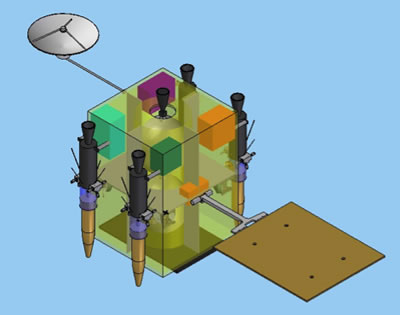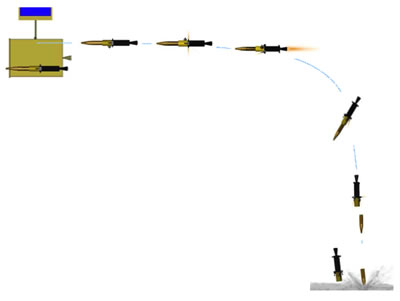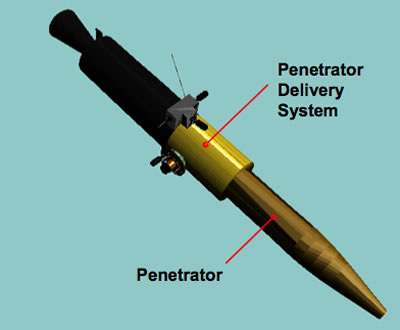Science Fiction
Dictionary
A B C D E F G H I J K L M N O P Q R S T U V W X Y Z
MoonLITE 'Mole' Penetrators For Lunar Exploration

The MoonLITE (Moon Lightweight Interior and Telecoms Experiment) project is a proposed collaboration by the British government and NASA. A satellite would be placed in orbit around the Moon carrying penetrator probes. These probes would be dropped from orbit, penetrating the lunar crust. Readings from shock-resistant instruments would be sent back to the orbiter, and then back to Earth.

(MoonLITE Lunar Orbiter working design [pdf])
The orbiting platform would consist of a large, high thrust propulsion system and associated support structure, including communications and navigation capabilities. Power would be provided by a single solar array. The platform would communicate with the penetrators at data rates ranging from 200 bps to 3kbs.
According to the UK Space Board's Professor Keith Mason:
"This joint report represents a milestone... The [plans] provide an opportunity to harness the UK’s world-class expertise in small satellite, communication and robotic technologies focused on exploration of the Moon... the UK is fully exploiting and strategically maximising its technological and scientific strengths in space exploration."
The primary science goals of the program are summarized as follows:
- Constraining the origin, differentiation, internal structure, and early geological evolution of the Moon.
- Gaining a better understanding of the origin and history of the volatile flux in the Earth-Moon system.
- Collecting of “ground truth” geochemical data for the calibration of orbiting remote-sensing instruments.
- Collecting in situ surface data that would help in the planning of future lunar exploration activities.
Initially, the platform would enter a 100 kilometer altitude circular orbit; it would come within 40 kilometers of the surface for deployment of penetrators. Following deployment, the orbiter would move into a higher orbit to increase long-term orbit stability.
The penetrator deployment sequence is shown below. After a free-fall of about 3.5 minutes, the penetrator realigns itself to assure a near-vertical impact. The final impact velocity is estimated at about 350 meters per second.

(MoonLITE penetrator impact launch sequence [pdf])
The Penetrator Delivery System is shown below in a conceptual sketch.

(MoonLITE Lunar penetrator delivery system design concept [pdf])
The penetrator instrument package would include the following capabilities:
- Accelerometer/tilt assembly
- Micro Electro Mechanical Systems (MEMS)- based microseismometer
- Pressure sensors, impedance spectrometer, compact mass spectrometer
- Sample collection and thermal control system is based on the drill and the pyrotechnic sample volume sealing device based on NASA Deep Space 2.
- Thermal sensors
- Geochemical analysis
- Microscope
- Radiation sensor
- Magnetometer
- Descent camera
The group believes that by deploying instruments to a variety of carefully chosen locations never before explored (including the poles and the lunar farside), MoonLITE penetrators have the potential to make major contributions to lunar science. The mission would also provide knowledge essenial to future human missions to the Moon, and demonstrate technology that could be used elsewhere in the solar system.
In his 1958 novel The Mechanical Monarch, EC Tubb writes about asteroid miners who want to know the composition of asteroids prior to actually landing on them. They use a projectile to blow some material into vapor, and then use spectral analysis to determine composition.
From Joint Working Group Report on Lunar Cooperation via The Register.
Scroll down for more stories in the same category. (Story submitted 2/20/2008)
Follow this kind of news @Technovelgy.| Email | RSS | Blog It | Stumble | del.icio.us | Digg | Reddit |
Would
you like to contribute a story tip?
It's easy:
Get the URL of the story, and the related sf author, and add
it here.
Comment/Join discussion ( 5 )
Related News Stories - (" Space Tech ")
Will Space Stations Have Large Interior Spaces Again?
'They filed clumsily into the battleroom, like children in a swimming pool for the first time, clinging to the handholds along the side.' - Orson Scott Card, 1985.
Reflect Orbital Offers 'Sunlight on Demand' And Light Pollution
'I don't have to tell you about the seven two-mile-diameter orbital mirrors...'
Chrysalis Generation Ship to Alpha Centauri
'This was their world, their planet —
this swift-traveling, yet seemingly moveless vessel.' - Nat Schachner, 1934
The First Space Warship For Space Force
'Each of the electrical ships carried about twenty men...' - Garrett P. Serviss, 1898.
Technovelgy (that's tech-novel-gee!) is devoted to the creative science inventions and ideas of sf authors. Look for the Invention Category that interests you, the Glossary, the Invention Timeline, or see what's New.
Science Fiction
Timeline
1600-1899
1900-1939
1940's 1950's
1960's 1970's
1980's 1990's
2000's 2010's
Current News
Bone-Building Drug Evenity Approved
'Compounds devised by the biochemists for the rapid building of bone...'
Secret Kill Switch Found In Yutong Buses
'The car faltered as the external command came to brake...'
Inmotion Electric Unicycle In Combat
'It is about the size and shape of a kitchen stool, gyro-stabilized...'
Grok Scores Best In Psychological Tests
'Try to find out how he ticks...'
PaXini Supersensitive Robot Fingers
'My fingers are not that sensitive...'
Congress Considers Automatic Emergency Braking, One Hundred Years Too Late
'The greatest problem of all was the elimination of the human element of braking together with its inevitable time lag.'
The Desert Ship Sailed In Imagination
'Across the ancient sea floor a dozen tall, blue-sailed Martian sand ships floated, like blue smoke.'
The Zapata Air Scooter Would Be Great In A Science Fiction Story
'Betty's slapdash style.'
Thermostabilized Wet Meat Product (NASA Prototype)
There are no orbiting Michelin stars. Yet.
Could Crystal Batteries Generate Power For Centuries?
'Power could be compressed thus into an inch-square cube of what looked like blue-white ice'
India Ponders Always-On Smartphone Location Tracking
'It is necessary... for your own protection.'
Amazon Will Send You Heinlein's Knockdown Cabin
'It's so light that you can set it up in five minutes by yourself...'
Is It Time To Forbid Human Driving?
'Heavy penalties... were to be applied to any one found driving manually-controlled machines.'
Replace The Smartphone With A Connected Edge Node For AI Inference
'Buy a Little Dingbat... electropen, wrist watch, pocketphone, pocket radio, billfold ... all in one.'
Artificial Skin For Robots Is Coming Right Along
'... an elastic, tinted material that had all the feel and appearance of human flesh and epidermis.'
Robot Guard Dog On Duty
I might also be thinking of K-9 from Doctor Who.
